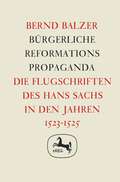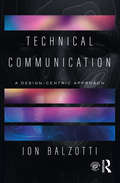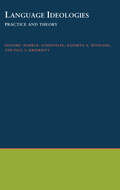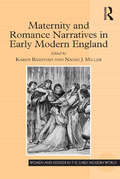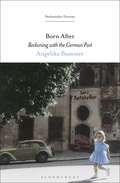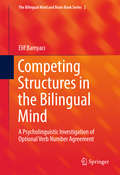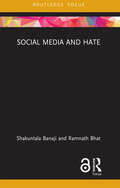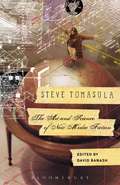- Table View
- List View
Technical Communication: A Design-Centric Approach
by Jon BalzottiTechnical Communication: A Design-Centric Approach is a comprehensive textbook for introductory courses in technical communication and professional writing. Technical Communication takes a design approach to foundational and emergent technical communication skills such as document design, job applications and interviews, workplace collaboration, and report writing, providing students with practical guidance on matters of ethics, style, and problem-solving in a range of professional and organizational contexts. This is a core textbook suitable for undergraduate courses in technical and professional communication.The book is supplemented by an innovative website featuring interactive simulations of various real-world technical communication challenges. Visit https://microcore.byu.edu/
Technical Communication: A Design-Centric Approach
by Jon BalzottiTechnical Communication: A Design-Centric Approach is a comprehensive textbook for introductory courses in technical communication and professional writing. Technical Communication takes a design approach to foundational and emergent technical communication skills such as document design, job applications and interviews, workplace collaboration, and report writing, providing students with practical guidance on matters of ethics, style, and problem-solving in a range of professional and organizational contexts. This is a core textbook suitable for undergraduate courses in technical and professional communication.The book is supplemented by an innovative website featuring interactive simulations of various real-world technical communication challenges. Visit https://microcore.byu.edu/
Narrative Development: Six Approaches
by Michael BambergGrowing out of an International Society of the Study of Behavioral Development-sponsored symposium, this book discusses the basic assumptions that led the contributors to conduct research in the field of narrative development. This collection gathers their research reflections and varying approaches to narrative and its development. It illustrates each type of approach and highlights their respective motives. The book presents some of the basic motivating assumptions of each approach and provides insight into what holds each set of assumptions together, potentially transforming them into actions. This book will serve as an excellent text for courses emphasizing multiple approaches to the study of narrative. The editor has organized this volume in accordance with the six main points of the symposium: * Specification of the Domain--how narratives are defined in terms of textual structures, knowledge thereof, interactive moves, sociocultural conventions, and the like. * The Individual's Involvement in the Developmental Process--the relationship between some internal or external forces and the organism's own active participation in the developmental process. * The Course of Development--if it is continuous or discontinuous; whether it proceeds in an additive fashion or whether regressive phases occur; and what changes at different points in the developmental process signify. * The Goal of Development--the implicit notion of a telos, a target or end-point that needs to occur in the developmental process. * Mechanisms of Development--the forces and/or conditions that both instigate the developmental process and keep it moving toward its telos. * Methodology--where and how to look in the establishment of a developmental framework. This book is an indispensable text in the fields of narrative and/or discourse, linguistics, language studies, psychology, and education in general.
Narrative Development: Six Approaches
by Michael BambergGrowing out of an International Society of the Study of Behavioral Development-sponsored symposium, this book discusses the basic assumptions that led the contributors to conduct research in the field of narrative development. This collection gathers their research reflections and varying approaches to narrative and its development. It illustrates each type of approach and highlights their respective motives. The book presents some of the basic motivating assumptions of each approach and provides insight into what holds each set of assumptions together, potentially transforming them into actions. This book will serve as an excellent text for courses emphasizing multiple approaches to the study of narrative. The editor has organized this volume in accordance with the six main points of the symposium: * Specification of the Domain--how narratives are defined in terms of textual structures, knowledge thereof, interactive moves, sociocultural conventions, and the like. * The Individual's Involvement in the Developmental Process--the relationship between some internal or external forces and the organism's own active participation in the developmental process. * The Course of Development--if it is continuous or discontinuous; whether it proceeds in an additive fashion or whether regressive phases occur; and what changes at different points in the developmental process signify. * The Goal of Development--the implicit notion of a telos, a target or end-point that needs to occur in the developmental process. * Mechanisms of Development--the forces and/or conditions that both instigate the developmental process and keep it moving toward its telos. * Methodology--where and how to look in the establishment of a developmental framework. This book is an indispensable text in the fields of narrative and/or discourse, linguistics, language studies, psychology, and education in general.
Language Ideologies: Practice and Theory (Oxford Studies in Anthropological Linguistics #16)
by Bambi B. Schieffelin & Kathryn A. Woolard & Paul V. Kroskrity"Language ideologies" are cultural representations, whether explicit or implicit, of the intersection of language and human beings in a social world. Mediating between social structures and forms of talk, such ideologies are not only about language. Rather, they link language to identity, power, aesthetics, morality and epistemology. Through such linkages, language ideologies underpin not only linguistic form and use, but also significant social institutions and fundamental nottions of person and community. The essays in this new volume examine definitions and conceptions of language in a wide range of societies around the world. Contributors focus on how such defining activity organizes language use as well as institutions such as religious ritual, gender relations, the nation-state, schooling, and law. Beginning with an introductory survey of language ideology as a field of inquiry, the volume is organized in three parts. Part I, "Scope and Force of Dominant Conceptions of Language," focuse on the propensity of cultural models of language developed in one social domain to affect linguistic and social behavior across domains. Part II, "Language Ideology in Institutions of Power," continues the examination of the force of specific language beliefs, but narrows the scope to the central role that language ideologies play in the functioning of particular institutions of power such as schooling, the law, or mass media. Part III, "Multiplicity and Contention among Ideologies," emphasizes the existence of variability, contradiction, and struggles among ideologies within any given society. This will be the first collection of work to appear in this rapidly growing field, which bridges linguistic and social theory. It will greatly interest linguistic anthropologists, social and cultural anthropologists, sociolinguists, historians, cultural studies, communications, and folklore scholars.
Love & Literacy: A Practical Guide to Finding the Magic in Literature (Grades 5-12)
by Paul Bambrick-Santoyo Stephen ChigerWhen our students enter middle and high school, the saying goes that they stop learning to read and start reading to learn. Then why is literacy still a struggle for so many of our students? The reality is that elementary school isn’t designed to prepare students for Othello and Song of Solomon: so what do we do? Love and Literacy steps into the classrooms of extraordinary teachers who have guided students to the highest levels of literacy. There is magic in their teaching, but that magic is replicable. It starts with a simple premise: kids fall in love with texts when they understand them, and that understanding comes from the right knowledge and/or the right strategy at the right time. Love and Literacy dissects the moves of successful teachers and schools and leaves you with the tools to make these your own: Research-based best practices in facilitating discourse, building curriculum, guiding student comprehension and analysis, creating a class culture where literacy thrives, and more Video clips of middle and high school teachers implementing these practices An online, print-ready Reading and Writing Handbook that places every tool at your fingertips to implement effectively Discussion questions for your own professional learning or book study group Great reading is more than just liking books: it’s having the knowledge, skill, and desire to experience any text in all its fullness. Love and Literacy guides you to create environments where students can build the will and wherewithal to truly fall in love with literacy.
Love & Literacy: A Practical Guide to Finding the Magic in Literature (Grades 5-12)
by Paul Bambrick-Santoyo Stephen ChigerWhen our students enter middle and high school, the saying goes that they stop learning to read and start reading to learn. Then why is literacy still a struggle for so many of our students? The reality is that elementary school isn’t designed to prepare students for Othello and Song of Solomon: so what do we do? Love and Literacy steps into the classrooms of extraordinary teachers who have guided students to the highest levels of literacy. There is magic in their teaching, but that magic is replicable. It starts with a simple premise: kids fall in love with texts when they understand them, and that understanding comes from the right knowledge and/or the right strategy at the right time. Love and Literacy dissects the moves of successful teachers and schools and leaves you with the tools to make these your own: Research-based best practices in facilitating discourse, building curriculum, guiding student comprehension and analysis, creating a class culture where literacy thrives, and more Video clips of middle and high school teachers implementing these practices An online, print-ready Reading and Writing Handbook that places every tool at your fingertips to implement effectively Discussion questions for your own professional learning or book study group Great reading is more than just liking books: it’s having the knowledge, skill, and desire to experience any text in all its fullness. Love and Literacy guides you to create environments where students can build the will and wherewithal to truly fall in love with literacy.
Great Habits, Great Readers: A Practical Guide for K - 4 Reading in the Light of Common Core
by Paul Bambrick-Santoyo Aja Settles Juliana WorrellA book that brings the habits of reading to life Great readers are not made by genetics or destiny but by the habits they build—habits that are intentionally built by their teachers. The early formal years of education are the key to reversing the reading gap and setting up children for success. But K-4 education seems to widen the gap between stronger and weaker readers, not close it. Today, the Common Core further increases the pressure to reach high levels of rigor. What can be done? This book includes the strategies, systems, and lessons from the top classrooms that bring the habits of reading to life, creating countless quality opportunities for students to take one of the most complex skills we as people can know and to perform it fluently and easily. Offers clear teaching strategies for teaching reading to all students, no matter what level Includes more than 40 video examples from real classrooms Written by Paul Bambrick-Santoyo, bestselling author of Driven by Data and Leverage Leadership Great Habits, Great Readers puts the focus on: learning habits, reading habits, guided reading, and independent reading. NOTE: Content DVD and other supplementary materials are not included as part of the e-book file, but are available for download after purchase
Great Habits, Great Readers: A Practical Guide for K - 4 Reading in the Light of Common Core
by Paul Bambrick-Santoyo Aja Settles Juliana WorrellA book that brings the habits of reading to life Great readers are not made by genetics or destiny but by the habits they build—habits that are intentionally built by their teachers. The early formal years of education are the key to reversing the reading gap and setting up children for success. But K-4 education seems to widen the gap between stronger and weaker readers, not close it. Today, the Common Core further increases the pressure to reach high levels of rigor. What can be done? This book includes the strategies, systems, and lessons from the top classrooms that bring the habits of reading to life, creating countless quality opportunities for students to take one of the most complex skills we as people can know and to perform it fluently and easily. Offers clear teaching strategies for teaching reading to all students, no matter what level Includes more than 40 video examples from real classrooms Written by Paul Bambrick-Santoyo, bestselling author of Driven by Data and Leverage Leadership Great Habits, Great Readers puts the focus on: learning habits, reading habits, guided reading, and independent reading. NOTE: Content DVD and other supplementary materials are not included as part of the e-book file, but are available for download after purchase
Maternity and Romance Narratives in Early Modern England (Women and Gender in the Early Modern World)
by Karen BamfordThough recent scholarship has focused both on motherhood and on romance literature in early modern England, until now, no full length volume has addressed the notable intersections between the two topics. This collection contributes to the scholarly investigation of maternity in early modern England by scrutinizing romance narratives in various forms, considering motherhood not as it was actually lived, but as it was figured in the fantasy world of romance by authors ranging from Edmund Spenser to Margaret Cavendish. Contributors explore the traditional association between romance and women, both as readers of fiction and as tellers of ’old wives’ tales,’ as well as the tendency of romance plots, with their emphasis on the family and its reproduction, to foreground matters of maternity. Collectively, the essays in this volume invite reflection on the uses to which Renaissance culture put maternal stereotypes (the virgin mother, the cruel step-dame), as well as the powerful fears and desires that mothers evoke, assuage and sometimes express in the fantasy world of romance.
Maternity and Romance Narratives in Early Modern England (Women and Gender in the Early Modern World)
by Karen Bamford Naomi J. MillerThough recent scholarship has focused both on motherhood and on romance literature in early modern England, until now, no full length volume has addressed the notable intersections between the two topics. This collection contributes to the scholarly investigation of maternity in early modern England by scrutinizing romance narratives in various forms, considering motherhood not as it was actually lived, but as it was figured in the fantasy world of romance by authors ranging from Edmund Spenser to Margaret Cavendish. Contributors explore the traditional association between romance and women, both as readers of fiction and as tellers of ’old wives’ tales,’ as well as the tendency of romance plots, with their emphasis on the family and its reproduction, to foreground matters of maternity. Collectively, the essays in this volume invite reflection on the uses to which Renaissance culture put maternal stereotypes (the virgin mother, the cruel step-dame), as well as the powerful fears and desires that mothers evoke, assuage and sometimes express in the fantasy world of romance.
Born After: Reckoning with the German Past (Psychoanalytic Horizons)
by Angelika BammerWhat do we do with pasts we inherit that carry shame? A major and original contribution to thinking about and grappling with the legacies of German and Nazi history, this book reflects on the relationship between history and memory through the personal narrative of a postwar German intellectual. Arguing that the pasts that haunt usare shaped both by the things people did and suffered and the affective traces the past leaves in memory, Born After is a powerful meditation on questions of guilt, complicity, loss, and longing. With bracing honesty and without sentimentality, Bammer draws on her own family story to think anew about a history that we have come to accept as familiar. Inflecting questions about history with questions about ethics, her book speaks to all those concerned with historical pasts that remain unreconciled.
Born After: Reckoning with the German Past (Psychoanalytic Horizons)
by Angelika BammerWhat do we do with pasts we inherit that carry shame? A major and original contribution to thinking about and grappling with the legacies of German and Nazi history, this book reflects on the relationship between history and memory through the personal narrative of a postwar German intellectual. Arguing that the pasts that haunt usare shaped both by the things people did and suffered and the affective traces the past leaves in memory, Born After is a powerful meditation on questions of guilt, complicity, loss, and longing. With bracing honesty and without sentimentality, Bammer draws on her own family story to think anew about a history that we have come to accept as familiar. Inflecting questions about history with questions about ethics, her book speaks to all those concerned with historical pasts that remain unreconciled.
Partial Visions
by Angelika BammerPositing that a radical utopianism is one of the most vital impulses of feminist politics, Partial Visions traces the articulation of this impulse in the work of Euro-American, French and German women writers of the 1970s. It argues that this feminist utopianism both continued and reconceptualized a critical dimension of Left politics, yet concludes that feminist utopianism is not just visionary, but myopic - time and culture bound - as well.
Partial Visions: Feminism And Utopianism In The 1970s (Ralahine Utopian Studies #16)
by Angelika BammerPositing that a radical utopianism is one of the most vital impulses of feminist politics, Partial Visions traces the articulation of this impulse in the work of Euro-American, French and German women writers of the 1970s. It argues that this feminist utopianism both continued and reconceptualized a critical dimension of Left politics, yet concludes that feminist utopianism is not just visionary, but myopic - time and culture bound - as well.
The Future of Scholarly Writing: Critical Interventions
by Angelika Bammer Ruth-Ellen Boetcher JoeresThis stimulating collection is the first to take on the issue of form and what it means to the future of scholarly writing. A wide range of distinguished scholars from fields including law, literature, and anthropology shed light on the ways scholars can write for different publics and still adhere to the standards of quality scholarship.
Competing Structures in the Bilingual Mind: A Psycholinguistic Investigation of Optional Verb Number Agreement (The Bilingual Mind and Brain Book Series #2)
by Elif BamyacıThis volume combines psycholinguistic experiments with typological investigations in order to provide a comprehensive exploration of the linguistic structure of verb-number agreement in bilingual speakers, with a particular focus on the Turkish language. It takes as its starting point the question of which linguistic structures pose difficulties for bilingual speakers, and then proceeds to evaluate the question by using the interface phenomenon of optional verb number agreement. In doing so, this volume investigates how the bilingual mind handles grammatical structures that demand high processing sources, working towards a processing-based linguistic framework for the bilingual mind. Beginning with a thorough survey of the current research of the interface phenomenon in the bilingual mind, the volume then proceeds to present two separate studies on each linguistic interface type, namely semantics-syntax interface and syntax-pragmatics interface, thus filling a number of gaps in the bilingualism research with regards to the interface phenomenon The results and conclusions of these studies are then integrated with current knowledge and research from the field within a theoretical and processing-based framework in order to explore new psycholinguistic insights for the bilingual mind, specifically the conclusion that the grammar of bilingual speakers is shaped according to cross linguistic tendencies. Ultimately, it provides a unified account and a comprehensive conclusion regarding the non-native-like patterns in grammar of bilingual speakers. Serving as a fascinating and timely resource, Competing Structures in the Bilingual Mind: An Investigation of Optional Verb Number Agreement will appeal to bilingualism researchers, clinical linguists, cognitive scientists, experimental linguists, and any linguist specializing in Turkic or Altaic languages.
Social Media and Hate (Routledge Focus on Communication and Society)
by Shakuntala Banaji Ramnath BhatUsing expert interviews and focus groups, this book investigates the theoretical and practical intersection of misinformation and social media hate in contemporary societies. Social Media and Hate argues that these phenomena, and the extreme violence and discrimination they initiate against targeted groups, are connected to the socio-political contexts, values and behaviours of users of social media platforms such as Facebook, TikTok, ShareChat, Instagram and WhatsApp. The argument moves from a theoretical discussion of the practices and consequences of sectarian hatred, through a methodological evaluation of quantitative and qualitative studies on this topic, to four qualitative case studies of social media hate, and its effects on groups, individuals and wider politics in India, Brazil, Myanmar and the UK. The technical, ideological and networked similarities and connections between social media hate against people of African and Asian descent, indigenous communities, Muslims, Dalits, dissenters, feminists, LGBTQIA communities, Rohingya and immigrants across the four contexts is highlighted, stressing the need for an equally systematic political response. This is an insightful text for scholars and academics in the fields of Cultural Studies, Community Psychology, Education, Journalism, Media and Communication Studies, Political Science, Social Anthropology, Social Psychology, and Sociology.
Social Media and Hate (Routledge Focus on Communication and Society)
by Shakuntala Banaji Ramnath BhatUsing expert interviews and focus groups, this book investigates the theoretical and practical intersection of misinformation and social media hate in contemporary societies. Social Media and Hate argues that these phenomena, and the extreme violence and discrimination they initiate against targeted groups, are connected to the socio-political contexts, values and behaviours of users of social media platforms such as Facebook, TikTok, ShareChat, Instagram and WhatsApp. The argument moves from a theoretical discussion of the practices and consequences of sectarian hatred, through a methodological evaluation of quantitative and qualitative studies on this topic, to four qualitative case studies of social media hate, and its effects on groups, individuals and wider politics in India, Brazil, Myanmar and the UK. The technical, ideological and networked similarities and connections between social media hate against people of African and Asian descent, indigenous communities, Muslims, Dalits, dissenters, feminists, LGBTQIA communities, Rohingya and immigrants across the four contexts is highlighted, stressing the need for an equally systematic political response. This is an insightful text for scholars and academics in the fields of Cultural Studies, Community Psychology, Education, Journalism, Media and Communication Studies, Political Science, Social Anthropology, Social Psychology, and Sociology.
Steve Tomasula: The Art and Science of New Media Fiction
by David BanashSteve Tomasula's work exists at the cutting edges of scientific knowledge and literary techniques. As such, it demands consideration from multiple perspectives and from critics who can guide the reader through the formal innovations and multimedia involutions while providing critical scientific, aesthetic, historical, and technical contexts. This book, the first of its kind, provides this framework, showing readers the richness and relevance of the worlds Tomasula constructs.Steve Tomasula's work is redefining the form of the novel, reinventing the practice of reading, and wrestling with the most urgent questions raised by massive transformations of media and biotechnologies. His work not only charts these changes, it formulates the problems that we have making meaning in our radically changing technological contexts. Vast in scope, inventive in form, and intimate in voice, his novels, short stories, and essays are read and taught by a surprisingly diverse array of scholars in fields ranging from contemporary experimental writing and literary criticism to the history of science, biotechnology and bioart, book studies, and digital humanities.
Steve Tomasula: The Art and Science of New Media Fiction
by David BanashSteve Tomasula's work exists at the cutting edges of scientific knowledge and literary techniques. As such, it demands consideration from multiple perspectives and from critics who can guide the reader through the formal innovations and multimedia involutions while providing critical scientific, aesthetic, historical, and technical contexts. This book, the first of its kind, provides this framework, showing readers the richness and relevance of the worlds Tomasula constructs.Steve Tomasula's work is redefining the form of the novel, reinventing the practice of reading, and wrestling with the most urgent questions raised by massive transformations of media and biotechnologies. His work not only charts these changes, it formulates the problems that we have making meaning in our radically changing technological contexts. Vast in scope, inventive in form, and intimate in voice, his novels, short stories, and essays are read and taught by a surprisingly diverse array of scholars in fields ranging from contemporary experimental writing and literary criticism to the history of science, biotechnology and bioart, book studies, and digital humanities.
Studying Verbal Irony and Sarcasm: Methodological Perspectives from Communication Studies and Beyond
by Natalia Banasik-Jemielniak Piotr Kałowski Maria ZajączkowskaThis volume provides a comprehensive yet accessible introduction to the phenomenon of verbal irony and sarcasm and the methodological aspects of its study. The chapters employ quantitative and qualitative measures of the use of verbal irony and sarcasm in both adults and children, with methods ranging from questionnaires and comment elicitation through experimental studies to a qualitative analysis of naturalistic data. By examining the phenomena in a range of contexts, the volume also show that cultural norms of communication may affect both the use and understanding of irony in specific ways and should therefore be taken into account in research.
The History of Zonaras: From Alexander Severus to the Death of Theodosius the Great
by Thomas Banchich Eugene LaneWhile an exile from Constantinople, the twelfth-century Byzantine functionary and canonist John Zonaras culled earlier chronicles and histories to compose an account of events from creation to the reign of Alexius Comnenus. For topics where his sources are lost or appear elsewhere in more truncated form, his testimony and the identification of the texts on which he depends are of critical importance. For his account of the first two centuries of the Principate, Zonaras employed now-lost portions of Cassius Dio. From the point where Dio’s History ended, to the reign of Theodosius the Great (d. 395), he turned to other sources to produce a uniquely full historical narrative of the critical years 235-395, making Books XII.15-XIII.19 of the Epitome central to the study of both late Roman history and late Roman and Byzantine historiography. This key section of the Epitome, together with Zonaras’ Prologue, here appears in English for the first time, both complemented by a historical and historiographical commentary. A special feature of the latter is a first-ever English translation of a broad range of sources which illuminate Zonaras’ account and the historiographical traditions it reflects. Among the authors whose newly translated works occupy a prominent place in the commentary are George Cedrenus, George the Monk, John of Antioch, Peter the Patrician, Symeon Magister, and Theodore Scutariotes. Specialized indices facilitate the use of the translations and commentary alike. The result is an invaluable guide and stimulus to further research for scholars and students of the history and historiography of Rome and Byzantium.
The History of Zonaras: From Alexander Severus to the Death of Theodosius the Great
by Thomas Banchich Eugene LaneWhile an exile from Constantinople, the twelfth-century Byzantine functionary and canonist John Zonaras culled earlier chronicles and histories to compose an account of events from creation to the reign of Alexius Comnenus. For topics where his sources are lost or appear elsewhere in more truncated form, his testimony and the identification of the texts on which he depends are of critical importance. For his account of the first two centuries of the Principate, Zonaras employed now-lost portions of Cassius Dio. From the point where Dio’s History ended, to the reign of Theodosius the Great (d. 395), he turned to other sources to produce a uniquely full historical narrative of the critical years 235-395, making Books XII.15-XIII.19 of the Epitome central to the study of both late Roman history and late Roman and Byzantine historiography. This key section of the Epitome, together with Zonaras’ Prologue, here appears in English for the first time, both complemented by a historical and historiographical commentary. A special feature of the latter is a first-ever English translation of a broad range of sources which illuminate Zonaras’ account and the historiographical traditions it reflects. Among the authors whose newly translated works occupy a prominent place in the commentary are George Cedrenus, George the Monk, John of Antioch, Peter the Patrician, Symeon Magister, and Theodore Scutariotes. Specialized indices facilitate the use of the translations and commentary alike. The result is an invaluable guide and stimulus to further research for scholars and students of the history and historiography of Rome and Byzantium.
